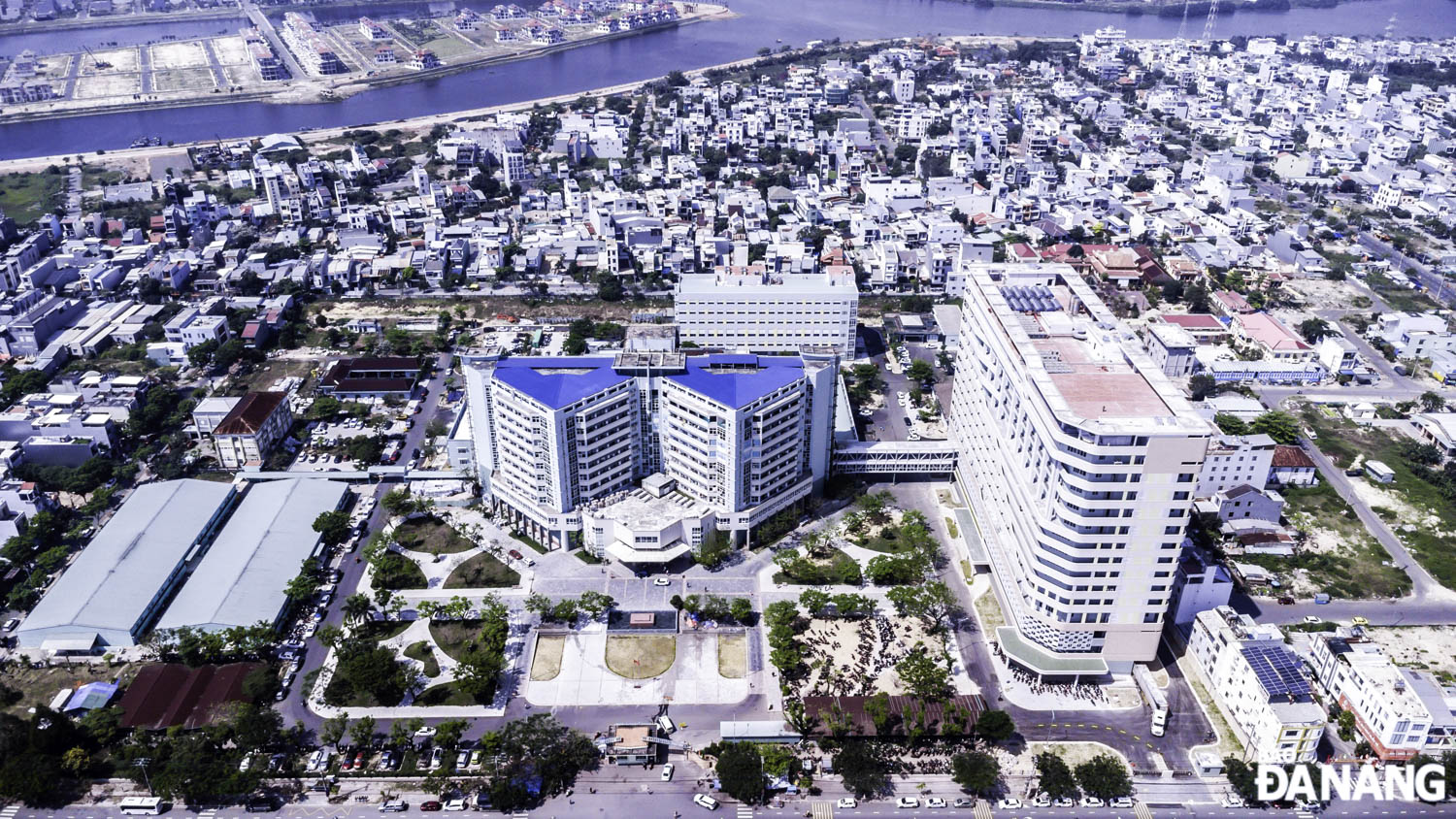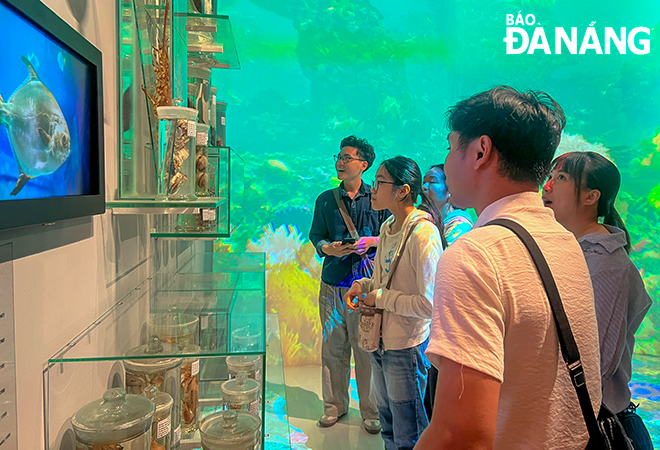Deep insight into national treasures, special national relics in Da Nang
Da Nang, for the time being, keeps 6 national treasures and 2 special national relics. Over recent years, this tourism hub has exerted continuous efforts in the conservation and promotion of heritages. Da Nang Today would like to sincerely introduce readers to information attached with valuable images of these unique treasures and relics as follows:
1. Dien Hai Citadel -special national relic site
Situated on the western side of the Han River, the Dien Hai Citadel, one of the most important fortresses in Viet Nam in the 19th century, was recognised as a special national historical relic in 2017 following approval by the Prime Minister.
 |
| Photo: Huynh Van Truyen |
The over 160-year-old citadel is vivid evidence of the undaunted courage and indomitable fighting spirit of Da Nang’s soldiers and its residents during their historic battles against the French-Spanish coalition forces in the 1858 - 1860 period.
In 2018, the Da Nang administration gave the nod to the spending of more than VND185 billion on restoring and embellishing the citadel in two phases. The intention is to preserve and reveal the aesthetic and historic value of the site. Especially, the whole process is based on respect for original material and authentic documents.
Ruins must be maintained and measures necessary for the permanent conservation, and protection of architectural features and of objects discovered must be taken. Furthermore, every means must be taken to facilitate the understanding of the monument, and to reveal it without ever distorting its meaning.
Replacements of missing parts must integrate harmoniously with the whole, but at the same time must be distinguishable from the original so that restoration does not falsify the artistic or historic evidence.
It is expected that the second phase of the project will be completed in 2024.
Once the restoration and embellishment project is completed, the citadel will become one of very inviting places in the city and a ‘do not miss’ site for visitors to learn more about the culture and history of Da Nang, emerging as the highlight of the landscape in the downtown square, and vividly recreating the old citadel with a heroic historical story as well.
Marble Mountains special national relic site
The Marble Mountains Tourist Area in Hoa Hai Ward, Ngu Hanh Son District, Da Nang has been recognised as a special national-level relic site by the Ministry of Culture, Sports and Tourism. Apart from its scenic charm, the site shows off its special, profound historical and cultural values.
 |
| Photo: Huynh Van Truyen |
As a precious gift of nature endowed to Da Nang, the Marble Mountains site in fact is a cluster of 6 limestone mounts, namely Kim Son, Moc Son, Thuy Son, Am Hoa Son, Duong Hoa Son, and Tho Son.
A lot of the legends and folklore about the mountains have been spread through by word of mouth.
One local tale is that the mountains originate from egg shells. Legend has it that a golden turtle came to the seashore and laid 5 eggs a long time ago. When the eggs hatched, their shells turned into 5 mountains.
Showing off its special historical and cultural values, the Marble Mountains Tourist Area was recognised as a special national-level relic site by Vietnamese Ministry of Culture, Sports and Tourism in 2018. Soon later, the Prime Minister pproved a project to renovate this pecial national scenic spot.
When restored, this relic site will become a special cultural and spiritual place in Da Nang.
3. Tra Kieu Altar
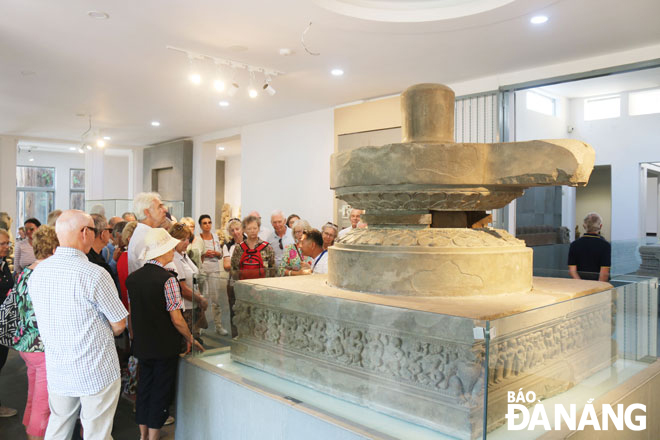 |
| Photo: the Da Nang Museum of Cham Sculpture |
Date: the 7th -8th centuries (?)
Origin: Tra Kieu, Quang Nam Province
Material: Sandstone
The Tra Kieu altar consists of the following parts: the top is a Linga, the middle is a Yoni pedestal with two round cutting boards skillfully decorated with symmetrical stylized lotus petals and the bottom is a square pedestal.
The four sides around the block are sculptured with 61 characters with diverse poses, movements and costumes.
The corners of the pedestals present a lion standing with their front legs to support the altar.
This altar is recognized as one of the sculpture masterpieces as well as one of the four existing National Treasures of the Museum. Immediately after being discovered, the altar attracted many researchers to decipher the stories of the characters on the altar and analyze its dating.
The altar was brought to the Da Nang Museum of Cham Sculpture in 1901 and recognised as a national treasure in 2012.
4. My Son E1 Altar
 |
| Photo: the Da Nang Museum of Cham Sculpture |
Date: 7th – 8th centuries
Origin: My Son, Quang Nam Province
Material: Sandstone
The altar consists of 16 blocks of stones but currently just remains 14 blocks. On top of the altar is likely to support a huge Linga – Yoni made of sandstone (now lost).
This is the only pedestal showing the life of monks (or Rishi) with various activities such as practice, ritual, teaching, meditation, resting in the sacred forests. In particular, there are unique details which simulate the architecture of a tower. In front of the steps also illustrates dancers performing a soft and vivid dance of the divine scarf to honor the Gods.
Another feature is that the altar showcases many iconic metaphors for a temple, representing the legendary mountain Meru in Indian mythology. Mount Meru and its peak Mount Kailasa is the abode of the gods and Shiva reigning on the top of the mountain, represented by the symbol of Linga – Yoni worship.
Also, noticeably, some patterns of floral décor and character costumes imply resemblances with the sculptures of both Mon-Dvaravati art in Thailand and pre-Angkor inCambodia in the 7th – 8th centuries.
Recognised as the national treasure in 2012, the altar was displayed at the Museum of Cham Sculpture.
5. Statue of Bodhisattva Tara/ Laksmindra Lokesvara
 |
| Photo: the Da Nang Museum of Cham Sculpture |
Date: Late 9th – Early 10th centuries
Origin: Dong Duong, Quang Nam Province
Material: Copper
In 1978, inhabitants in Binh Dinh Commune, Thang Binh District, Quang Nam Province discovered a nearly 1.15m high bronze goddess statue which was buried near the Dong Duong relic. The statue shows the goddess standing upright, both hands putting forward. The right hand holds the lotus flower whilst the left hand holds the shell (both are broken).
The square face, the large, curved and intersecting eyebrows, big nose, thick lips are the reminiscent of Dong Duong style.
This work is one of the most important bronze statues of Tara discovered in Southeast Asia. The artifact was recognized as a national treasure in 2012 and it is being on display at the Da Nang Museum of Cham Sculpture.
6. Dong Duong Altar
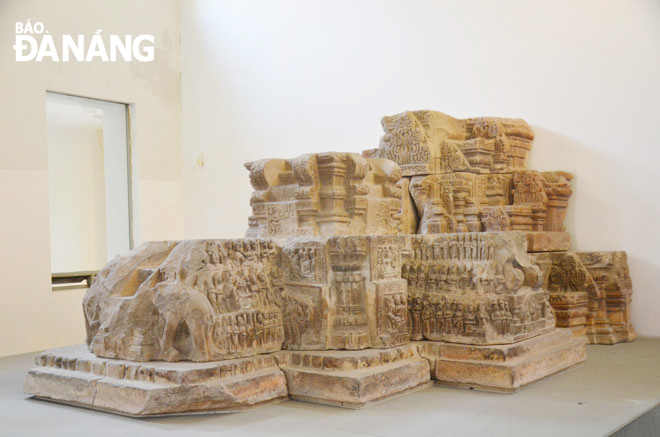 |
| Photo: the Da Nang Museum of Cham Sculpture |
Date: Late 9th century – early 10th centuries
Origin: Dong Duong, Quang Nam Province
Material: Sandstone
This is the altar found in the main west tower where it is said to worship the bodhisattva Laksmindra Lokesvara - the master deity of the Buddhist monastery.
The altar consists of 24 stone blocks assembled together to create a monumental structure with four parts: the base placed at the bottom, the large square ground altar, the small, square altar above the large altar and the taller altar pressed against the back of the large altar.
The exhibit is unique evidence proving a brilliant development period of the Champa Kingdom in the 9th – 10th centuries. The sculptural lines and decorative patterns on the altar are considered as one of the characteristic elements representing an important art style in the historical development of Champa sculpture.
The altar was recognized as a National Treasure in 2018 and displayed at the Museum of Cham Sculpture.
7. Statue of Ganesha
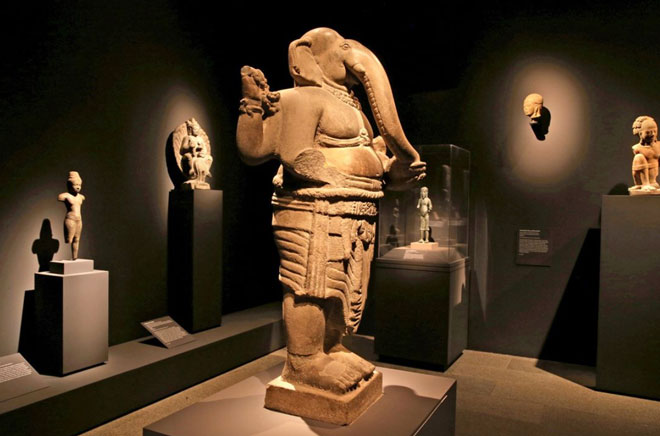 |
| Photo: Metropolitan Museum, New York |
Date: 7th century
Origin: My Son, Quang Nam Province
Material: Sandstone
The theme of Lord Ganesha is not commonly presented in the Champa sculptures still preserved to this day. This is one of the exceptional works that is relatively intact and boasts many unique features of the early Champa sculpture art.
Ganesha is among the most ancient deities of Hindu temples and also the most popular one as his capacity to remove all difficulties and hurdles in life. Lord Ganesha has been worshipped by Hinduism communities till today.
The statue was discovered in 1903 by archeologists from the Ha Noi-based L’École Française d’Extrême-Orient (EFEO) whilst conducting an excavation at the E5 tower at the My Son relic, Quang Nam Province.
Afterwards, the statue has been kept at the museum for display since 1918.
This is one of the rare round statues showing the deity in standing form, relatively intact, large in size and with many unique stylistic features in the early period - around the 7th -8th centuries in Viet Nam.
The artifact was recognised as a national trreasure in 2020 and it is displayed at the Museum of Cham Sculpture currently.
8. Statue of Gajasimha
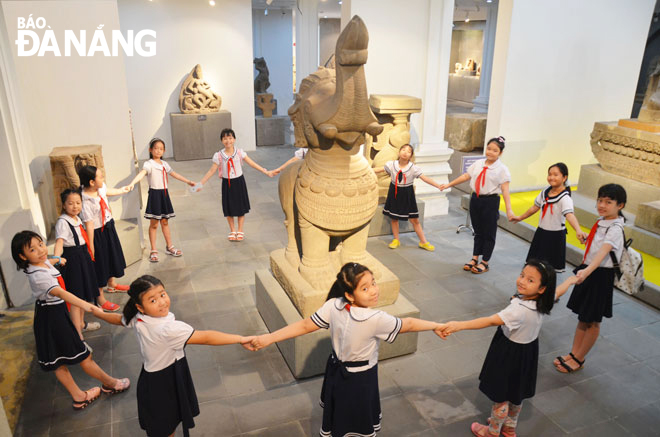 |
| Photo: the Da Nang Museum of Cham Sculpture |
Date: 12th century
Origin: Thap Ma, Binh Dinh Province
Material: Sandstone
The statue of Gajasimha mythical animal measuring 215cm in height, 100cm in length and 84cm in width.
It was discovered during an excavation at Thap Mam in Binh Dinh central province in 1933 - 1934 and has been kept in the museum since 1935.
The art piece demonstrates the head of an elephant, the neck wearing a rattle, the chest hair stylised with the stripes often seen on the statues of the Thap Mam period. This sacred animal is a prominent and popular subject for many Champa sculptures during this period.
The artifact was recognized as a national treasure in 2020.
Reporting by NGOC HA – Translating by A.THU


